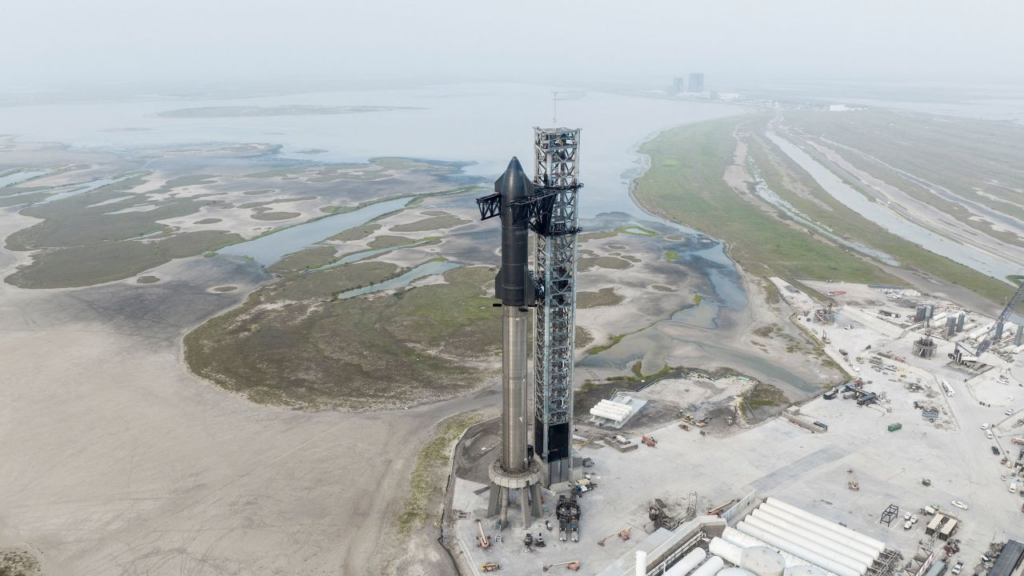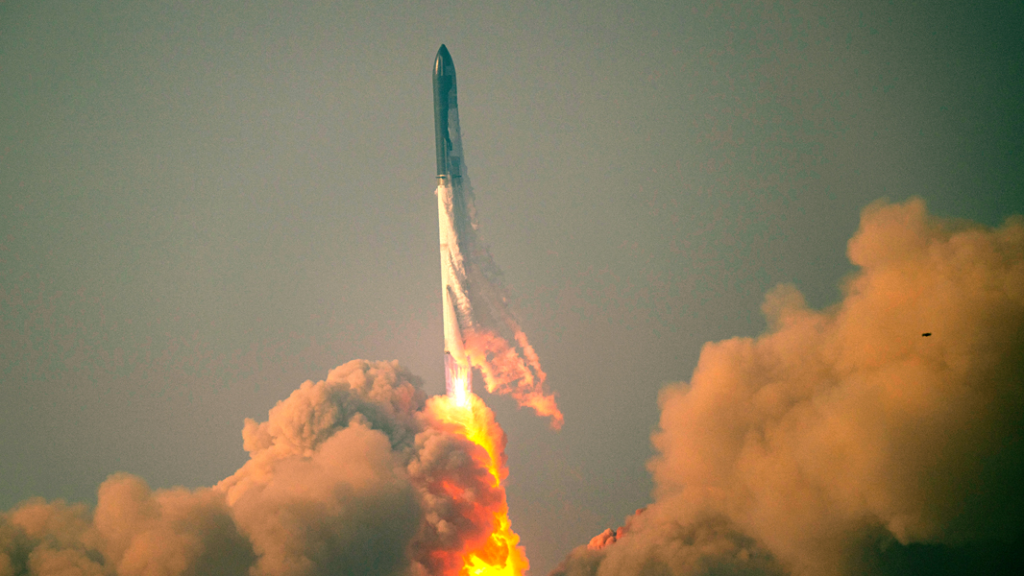
How A Water Deluge System Could Help SpaceX’s Pad Problems
Looking at different notable rocket launches within the space industry, often times the launch pad plays an equally important part in the mission results. A launch is an immensely violent process that creates both a destructive exhaust and even sound waves that if not properly accounted for, can wreak havoc on the rocket and surrounding structures.
Recently during Starship’s first launch, we saw the effect of the world’s most powerful rocket on the pad, nearby structures, and possibly the rocket itself. While SpaceX plans to add water cooled steel plates to account for the power of the Raptor’s exhaust, a water deluge system has a separate but equally important job. Based on the recent launch, it brings up questions of whether or not a system is needed for Starship.
A water deluge system is a way to help suppress both sound waves and flames by releasing mass amounts of water under the rocket. An important system that many rockets would not consider launching without. Here I will go more in-depth into how this system could help Stage 0 and Starship, the dangers of uncontrolled sound waves, what we can expect in the coming months, and more.
Stage 0 Water Deluge

During a rocket launch, there are two main factors related to the exhaust of the engines that you need to consider. One is the actual power and force that’s applied from these engines and the proximity to the ground, the other is the sound waves produced. As engine exhaust gasses exceed the speed of sound, they collide with the ambient air, and shockwaves are created, with noise levels approaching 200 decibels. While this might not seem like a big deal, in reality, this energy can be reflected by the launch platform and pad surfaces, and could potentially cause damage to the launch vehicle, payload, and even crew.
During Starship’s most recent launch, we saw an immensely strong engine ignition followed by a crater begin formed and concrete debris flying in every direction. We even saw damage to the Starship rocket itself with multiple Raptor engines failing throughout the flight. Recently, Elon highlighted that SpaceX had already been working on a water cooled steel plate that would be installed under the launch mount. While this steel plate is intended to solve the bulk of the Raptor engine exhaust, there’s even more they could do to protect the pad and rocket.
Throughout the space industry, water-based acoustic suppression systems are common on launch pads. They aid in reducing acoustic energy by injecting large quantities of water below the launch pad into the exhaust plume and in the area above the pad. Flame deflectors or flame trenches, or in SpaceX’s case, the steel plates, are designed to channel rocket exhaust away from the launch pad but also redirect acoustic energy away. When NASA’s Space Launch System (SLS) rocket lifts off, its four RS-25 engines and two solid rocket boosters produce a combined 8.4 million pounds of thrust, and with that comes a torrent of heat and noise. To help protect the SLS rocket, Orion spacecraft, Mobile Launcher, and launch pad from the extreme acoustic and temperature environment, water will spray onto the launch pad during ignition and liftoff. In comparison, Starship when launching with 33 operational Raptor engines is intended to produce around 16.7 million pounds of thrust, about twice as much as SLS.
To put in perspective the amount of water used during a launch, videos of NASA testing the system without a launch vehicle show it clearly. During a water deluge test in preparation for SLS, thousands of gallons of water flowed into the flame trench and through upgraded systems at NASA Kennedy Space Center’s Launch Pad 39B.
The test included a preliminary phase to flow about 150,000 gallons (570,000 liters) of water at high speed from a holding tank through all of the new and modified piping and valves at the flame trench, through the nozzles at the top of the flame deflector and mobile launcher interface pipes at the pad. On the second day, approximately 450,000 gallons (1,700,000 liters) of water flowed through the systems. At peak flow, the water reached about 100 feet (30 meters) in the air above the pad surface. This system in tandem with the flame diverter, helped protect the pad during the first launch of SLS. It’s important to point out however that after the first launch of SLS, even with all these systems in place, the pad still sustained some damage with elevator doors for example being blown out from the pressure and power of the exhaust. In reality, it’s extremely difficult to properly redirect and control the exhaust of some of the most powerful rockets in the world. We can expect that going forward SpaceX will spend a lot of time and testing on the proper pad systems that can handle 33 Raptor engines at full thrust. Something much easier said than done.
Violent Noise

In SpaceX’s case, a decent amount of work is needed to install a proper system capable of suppressing the flames and soundwaves produced by Super Heavy. On Launchpad 39B, they have a dedicated water tower for the Ignition Overpressure and Sound Suppression System (IOP/SS). This water is dumped on the mobile launcher and inside the flame trench in less than 30 seconds. The peak flow rate is 1.1 million gallons per minute, high enough to empty roughly two Olympic-size swimming pools in one minute. At Stage 0, SpaceX has the propellant tank farm which could be used but not to the same effect. The height and size of a dedicated water tower helps pressurize the water, not to mention the large diameter pipe for transport.
As of right now, it’s not fully clear what exactly SpaceX plans to do. With the exception of installing a water-cooled steel plate, it’s possible they just leave it at that. On the other hand, different rockets create different exhaust and sound profiles no matter the power. While in the past, there are cases of rockets being damaged due to the lack of a water deluge system, the soundwaves are produced and interact with each vehicle differently. Dr. Phil Metzger recently said in a tweet relating to Starship’s first launch, “So I have no idea of the acoustics experienced by Starship or its structural beefiness. It may not be a problem at all, for all I know. I’m just saying that a flat steel plate does not do anything to reduce acoustic energy from coupling into the vehicle. If the rocket doesn’t mind the shaking, then fine. But it is easy to design systems that reduce launch acoustics and give more margin back to the vehicle, so if SpaceX decided to do so, then it could be done,” he said.
After all, Starship is a very different vehicle from anything we have seen in the past. The first launch proved that Stage 0 100% needs a flame diverter or steel plate related system, however, maybe a water deluge system would be extra. Based on SpaceX’s methodology and how they go about testing rockets, it’s possible that between now and the next launch they only install the water cooled steel plate and leave it at that. They would then test that standalone system during the next launch attempt and go from there. Maybe it works out fine or maybe the launch causes more issues related to soundwaves. At the end of the day, SpaceX gathered mass amounts of information and data from the first launch. With this, they will work to make the most educated and timely solution. Something we will have to keep an eye on in the coming months.
During a rocket launch, the reason there is a shockwave is because a converging-diverging rocket nozzle tricks the gas flow into going supersonic. The fuel burns in the combustion chamber and creates high pressure. The restriction at the throat causes the gas to “choke” at the speed of sound. As it goes downstream from the throat it expands, cools, and speeds up to go supersonic. But initially, it has to push the ambient air out of the nozzle. The supersonic flow is ramming into the ambient air as it pushes it, creating a big buildup of pressure…the ignition shock.
That shockwave is slowly pushed down the nozzle (“slow” meaning a tiny fraction of a second). At the end of the nozzle, it detaches then goes down and hits the launch pad. It then reflects and travels up to the rocket, running up along its sides, shaking the structure. After the initial overpressure, the rocket exhaust continues to produce acoustic noise. It does this through turbulence. The noise is random — not like a coherent shockwave — but it is still a lot of energy that reflects off the pad and vibrates the rocket. Dr. Phil Metzger continued by pointing out, “We do not have great models of acoustic noise production in rocket plumes. NASA’s models are conservative, predicting more noise than there really is. Therefore we build rocket structures stiffer than they really need to be. This wastes the mass margin, reducing payload mass. So it is important to keep researching rocket plume acoustics to make rockets more efficient. But also, it is important to design launch pads to reduce acoustics so we can save more payload margin.”
Starship is obviously a very structurally sound rocket, whether or not it can stand up to the shockwaves procured during liftoff is not fully clear. With Elon estimating the next launch will happen in only 1 to 2 months, we can expect constant work at Starbase to repair and get ready for another attempt.
Conclusion
SpaceX recently launched the most powerful rocket in the world and caused some significant damage to Stage 0. While most rocket launches with less powerful rockets feature a flame diverter and water deluge system, SpaceX used neither. Currently, work is being completed to install a water cooled steel plate to account for the power of the Raptor exhaust. We will have to wait and see how it progresses and the impact it has on the space industry.
